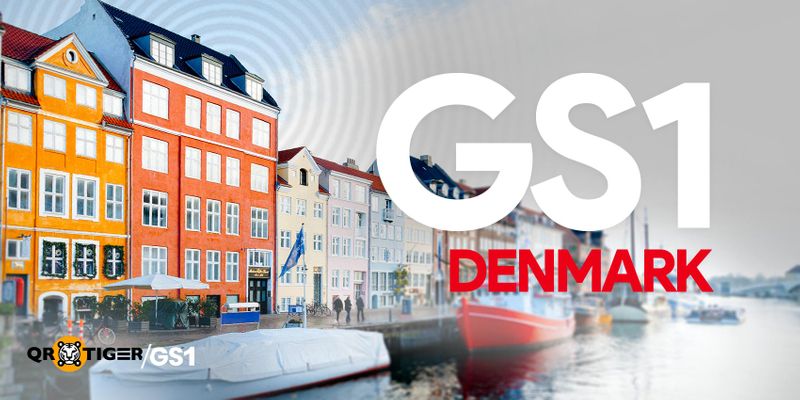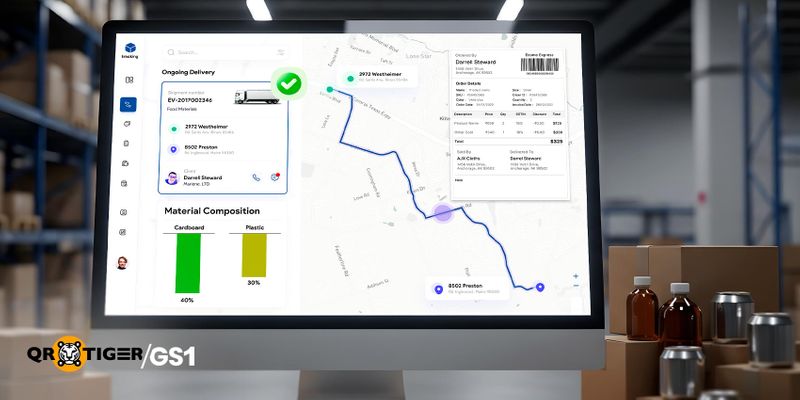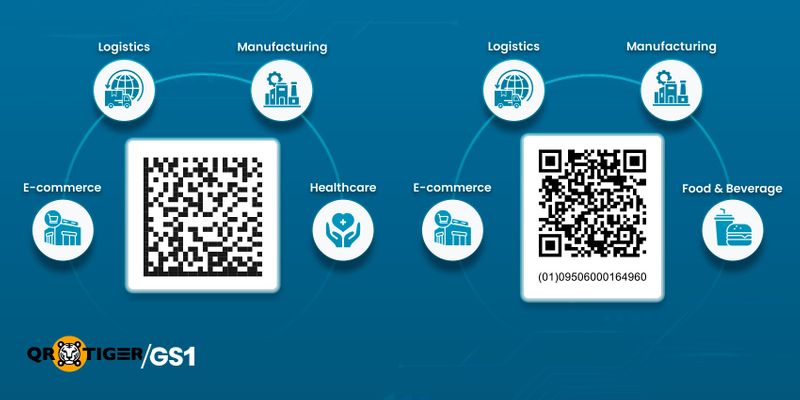GS1 Denmark: Empowering Industries with Global Standards

From manufacturing and logistics to healthcare, industries operating across Denmark depend on standardized systems to manage product data, improve traceability, and meet global trade requirements. As companies shift toward digital systems, it’s important to identify products correctly and share data effectively.
GS1 Denmark plays a key role in this evolution by providing globally recognized standards like GTINs (Global Trade Item Numbers), GLNs (Global Location Numbers), and barcodes that help Danish businesses work efficiently, reduce errors, and comply with industry regulations.
This blog will cover how GS1 helps industries adopt global barcode standards, manage product data more effectively, and transition to 2D barcodes. By doing so, it strengthens traceability, enhances trade safety, and streamlines operations across the supply chain.
Table of Contents
What is GS1 Denmark?
Created in 1977, GS1 Denmark (DK) was first known as EAN Denmark. It is the Danish division of the global standardization organization GS1.
It’s the only authorized entity licensed to issue GS1 barcodes and GTINs in Denmark. It helps businesses build more efficient, secure, and sustainable supply chains. This includes using barcodes for product and shipment tracking to enable the smooth exchange of master data, purchase orders, and invoices.
The member organization(MO) is responsible for sharing, developing, and managing GS1 standards, following GS1’s global guidelines.
Contact information:
Address: Vesterbrogade 149, 1620 Copenhagen V, Denmark
Contact no: +45 39 27 85 27
Email: info@gs1.dk
Introduced initiatives and collaborated campaigns
GS1 DK partners with industry leaders to encourage the use of global standards that support digital innovation.
Producer Responsibility for Packaging (Producentansvar for emballage)
If your company uses packaging or produces packaged products in EU, you must follow the Producer Responsibility for Packaging.
In Denmark, this directive was put into effect under the Environmental Protection Act and an executive order issued on December 30, 2024, with ongoing reporting starting October 1, 2025.
Producer responsibility follows the 'polluter pays principle' that states that if your company makes, imports, or distributes packaged items, you’re responsible for it when it becomes waste and must pay for its disposal.
It helps support a circular economy. By using less packaging and choosing recyclable materials, companies can cut costs and protect the environment.
Producer responsibility will fully apply from October 2025, but affected companies already have some obligations to follow.
GS1Trade Packaging helps you work smart with your packaging data. It helps you collect, organize, and declare your packaging data that can be easily shared with others.
Collaboration for less medical waste and greater patient safety
Denmark has the technology and data to cut down on medicine waste and prevent treatment mistakes. But many hospitals haven’t started using these tools fully. The questions were -what’s stopping them, and what political steps are needed to help.
Wasted medicine and errors affect both the environment and patient safety. At the Danish People’s Festival, experts, politicians, and healthcare workers talked about how better use of data and digital tools could solve these problems and make healthcare greener and safer.
One idea is to use the barcodes already printed on medicine packages. These barcodes include important info like expiry dates, just like food items in stores. If hospitals use this data better, it could help a lot.
GS1 DK emphasized the potential of using barcodes on medicine packages, which contain key information like expiry dates, to prevent errors and reduce waste. With this collaboration, GS1 DK aims to build a greener, safer healthcare system.
This event also launched a new national partnership to fight medicine waste. It brings together healthcare, tech, and industry experts to find smart, practical ways to reduce waste across Denmark.
New rule on nonfood ingredient list for beauty products
GS1 DK is collaborating with industry partners to develop a new data model for beauty products. To support this, we’ve formed a network group that includes both suppliers and retailers.
The goal of the data model is to define which product fields are optional and which are mandatory when entering beauty items into GS1Trade Sync, a shared data pool used to exchange product information with trading partners.
As the network group reaches agreement, the model will be updated to reflect which fields must be completed. For example, if a product is missing its ingredient list, GS1Trade Sync will flag it with a red error.
GS1 DK services for businesses
GS1 provides helpful tools and services that make it easier for businesses to improve how they work and foster innovation across industries.
GS1ID
With GS1ID, you can create unique ID numbers for products, places, and shipments. GS1 offers up to 12 global standards to help businesses run smooth and efficient supply chains. The most common IDs include GTIN for products, GLN for locations, and SSCC (Serial Shipping Container Code) for shipments like pallets.
To use GS1ID, your company needs to apply for GS1 membership and request a GS1 Company Prefix (by submitting required documents and payment). Subsequently, submit a barcode number request and mention the number of GTIN-13 or GTIN-14 numbers your business needs. GS1 DK issues barcode numbers within a few working days.
The most popular GS1 standards for identification.
GS1ID offers you access to generate identification numbers for a wide range of global standards. The well-known identification numbers are listed here:
Identification number type | Used for | Examples |
GTIN | Products | Retail items, Medicine, Consumer Electronics |
GLN | Locations and other legal entities | Companies, warehouses, factories, shops |
SSCC | Logistics units | Packages, pallets, roll cages, containers |
GRAI (Global Returnable Asset Identifier) | Returnable units | Pallets, roll cages, containers |
GIAI (Global Individual Asset Identifier) | Assets | Medical, manufacturing, transportation, and IT equipment |
GSRN (Global Service Relation Number) | Service provider and recipient relationship | Members of the loyalty scheme, doctors in a hospital, and library members |
GS1Trade Activate
GS1Trade Activate (formerly known as GS1Trade Barcode) helps you keep track of your product and location numbers in one digital place. It replaces manual Excel sheets with a cloud-based system, making it easier to manage your numbers and create barcodes for products and shipments.
The service is free for GS1 Denmark members. Once the prefix is added to GS1Trade Activate, you can start generating barcodes based on your GTINs and see how many you've used.
How does GS1Trade Activate help your business?
Track GTIN: GS1Trade Activate helps you see how many product ID numbers (GTINs) you've used and what they're for. You can also check if your GTINs are still active. The tool automatically gives you the next available GTIN and lets you create barcodes for your products.
It’s also linked to the GS1 Registry Platform and supports Verified by GS1, so your product data stays accurate and trusted.
Track GLN: GS1Trade Activate helps you see what your (GLNs) are used for and whether they’re still active. Just like with GTINs, it gives you a clear overview and keeps everything organized.
Generate barcodes: GS1Trade Activate makes it easy to create barcodes from your GTINs. There is an option to create barcodes using manual input, just like in the old GS1Trade Barcode system.
GS1Trade Sync
GS1Trade Sync helps you collect, validate, and share product data and images in one place. You just enter or update your product info, and your trading partners can see it right away.
The system follows validation rules and data models to make sure all important and legal details are included for each product. This saves you time and gives you confidence when sharing data.
Instead of using Excel sheets, you get a faster way to create and share product master data in real time. You also join a global data community, making it easier to trade with others.
GS1Trade Sync supports key regulations such as GPSR (General Product Safety Regulation), EUDR (European Union Deforestation Regulation), and SUP (Single Use Plastics Directive) by offering clear data fields in the system that help you stay compliant.
Once your products are set up in GS1Trade Sync, you can share accurate data with all your partners at once, which saves you time, boosts efficiency, and improves data quality.
GS1Trade Exact
GS1Trade Exact helps you make sure your product data is accurate and matches the real product. It checks the product against the details you entered in GS1Trade Sync or helps you add the data if needed.
Once your product is approved, it gets a green stamp in GS1Trade Sync. This informs your trading partners that the data has been checked and is reliable.
With correct and complete data, you avoid mistakes in orders and deliveries, save money, and work more efficiently. The service also helps you follow legal rules, protect your business, and build trust. The quality data also improves online visibility, which can lead to more sales.
GS1Trade Image
GS1Trade Image gives you high-quality product photos that retailers and foodservice companies need. These images are stored in GS1Trade Sync, so you can easily share them with your partners and customers for use in webshops, promotions, and shelf planning.
You can request different types of images, such as packshots, digital renders, or lifestyle shots. All images follow industry and GS1 standards, so they’re ready for marketing.
With packshots, you get a full set of images in the right format and quality. The number of images depends on your packaging, and we deliver them in PNG and JPG formats.
Getting your images is simple:
- Send your product to GS1Trade Image and Exact in Ballerup
- The service prepares your images within 10 business days (or 5 days with express service)
- You’ll receive the images in GS1Trade Sync, ready to share with partners and customers
- You’ll get your product back (or GS1 donate/dispose of it based on your agreement)
GS1Trade Transact
GS1 Trade Transact is a reliable EDI (Electronic Data Interchange) solution that can be integrated into your financial system. It helps you send and receive orders and invoices digitally. It works with your financial system or can be used online.
The system makes sure you send the right details so your invoices get approved the first time. The process is handled automatically; your customers don’t need to worry about how they send or receive documents. It saves time and cuts down on manual work.
GS1Trade Packaging

GS1 Trade Packaging helps you easily collect, organize, and report packaging data. It shows what your product packaging is made of and helps you follow packaging laws and make your packaging more eco-friendly.
You can receive data from suppliers and safely share it with private label customers or your collective scheme.
GS1 Trade Packaging lets you track updates to your packaging data (such as master details, volumes, and declarations). This suggests that the system helps you monitor your packaging on your own.
Applications of 2D barcodes across industries in Denmark
By 2027, stores and brands will start using 2D barcodes to label products. These new barcodes can hold more details than the old 1D ones, making it easier to track items and connect with customers.
This change is part of the GS1 Sunrise 2027 initiative, which aims to make shopping clearer and faster, whether you're buying online or in a shop. Right now, switching to 2D barcodes (like GS1 DataMatrix and GS1 QR code) is optional, and some businesses may still use 1D barcodes based on their industry rules.
To make the switch smoother, companies are advised to add both types of barcodes on packaging. This way, current systems keep working while getting ready for future upgrades in retail technology.
To get ready for the Sunrise 2027, companies have two main choices for creating GS1-compliant 2D barcodes: create them in-house by following GS1’s implementation guidelines or use reliable tools like QR Tiger’s GS1 QR code generator to do it for you.
If a business lacks enough time or tech skills, these external services can help create and add barcodes quickly and reliably, making the transition easier.
Here are some of the key applications of these codes across industries in Denmark:

Retail
2D barcodes are being adopted across the Danish retail sector to replace traditional EAN-13 linear barcodes. These codes enable faster point of sale transactions. With a single scan of a GS1 Digital Link QR code, shoppers can instantly access product details, reviews, allergen info, recipes, and brand content.
Retailers use these barcodes to better manage inventory, make checkout faster, and facilitate dynamic pricing and loyalty programs.
Healthcare
The healthcare sector started using GS1 DataMatrix barcodes in 2019 to improve patient safety and medication traceability. These 2D codes are now widely used on medical devices, surgical instruments, and pharmaceuticals to encode batch numbers, expiry dates, and GTINs in a compact format.
Hospitals and pharmacies can scan products faster and more accurately, with fewer mistakes. GS1 DK supports this through alignment with the EU Falsified Medicines Directive (FMD) and Danish Medicines Agency guidelines. This alignment ensures products are correctly verified and securely tracked.
Transport and Logistics
In the logistics industry, 2D barcodes are used to track pallets, containers, and individual packages. These codes carry location data, SSCCs, and handling instructions, making warehouse operations smoother and speeding up international shipping.
The GS1 global standard Scan4Transport lets logistics and transport companies include key shipment details (such as handling instructions, delivery address, and hazard warnings) inside a 2D barcode printed on the label. It helps the team quickly address issues (such as missed or damaged items) and reduce errors.
Manufacturing
Manufacturers use these next-generation barcodes to manage production batches, quality control, and product recalls. For example, GS1 DataMatrix codes are printed directly on components and packaging to encode lot numbers, GTINs, and timestamps, supporting effective tracking and digital audits.
GS1 Digital Link plays a key role in helping manufacturers meet circular economy goals by enabling smarter packaging and full lifecycle tracking of product data.
Inspiring success stories from GS1 DK
GS1 DK has helped businesses in several industries improve tracking, safety, and efficiency using barcodes. This shows how GS1 standards make supply chains smarter and build consumer trust.
Aarhus University Hospital
At Aarhus University Hospital’s Elderly Diseases Department, staff had trouble finding each other during busy shifts, causing delays and stress. To fix this, the hospital started using GS1’s location-based identification system.
Each staff member carries an RFID or EPC tag with a unique identification code. The hospital’s system tracks their location by detecting these codes through installed scanners, which record when and where each person enters or leaves an area.
The hospital used GS1’s Electronic Product Code Information Services (EPCIS) system to safely manage and share staff location data. It helped their IT systems track movements in a standard format, ensuring compatibility across departments and future scalability.
Aalborg University Hospital
Aalborg University Hospital needed a simple and trusted way to manage nutrition for over 900 patients daily; many of these had allergies, swallowing issues, or were at nutritional risk.
They wanted to make sure food information stayed accurate and up to date without checking everything manually. In healthcare, even small changes in ingredients or nutrients can seriously affect patient safety, so getting the details right was essential.
GS1 addressed this need by providing standardized product data through services like GS1Trade Exact and GS1Trade Sync.
GS1Trade Sync served as a live database where food suppliers added details like nutrition, allergens, and ingredient changes. The hospital’s system could then pull the latest info automatically, so staff didn’t have to manually check whether a food’s protein content or allergen profile had changed.
GS1Trade Exact enhanced the validation by comparing supplier data with the real products, making sure the digital records reflected the actual products received. This extra step built trust and helped the hospital stay compliant.
By using both GS1Trade Sync and GS1Trade Exact, Aalborg University Hospital was able to serve safe, personalized meals and improve care for patients.
 Enabling Smarter Operations for Denmark’s Businesses
Enabling Smarter Operations for Denmark’s Businesses
GS1 Denmark empowers businesses to operate with greater transparency, accuracy, and digital readiness. Its services range from barcode registration to Verified by GS1, helping companies improve traceability, reduce errors, and meet both local and international compliance standards.
By adopting GS1 standards, Danish industries can optimize operations, enhance consumer trust, and prepare for future innovations like 2D barcode scanning at point-of-sale. Joining GS1 gives businesses access to trusted global standards, helping them work smarter, grow faster, and stay competitive in the digital world.
Frequently asked questions
1. What is a GS1 ID and why is it important?
A GS1 ID refers to the service of acquiring identifiers like GLN, GTIN, and SSCC that are used to uniquely identify locations, products, and logistics units. These IDs are essential for global trade, supporting accurate tracking, inventory control, and effective data exchange throughout supply chains.
2. What is the cost of GS1 DK membership and barcode services?
To access GS1 standards and services, you must become a GS1 Denmark member. Annual membership costs 515 DKK and includes one GLN/EAN.
For generating identification numbers (e.g., GTIN, GLN, SSCC), GS1 offers GS1ID subscriptions based on quantity:
GS1ID Tier | Annual Price (DKK) |
1 ID | 257.50 |
10 IDs | 1,133.00 |
100 IDs | 1,442.00 |
1,000 IDs | 1,751.00 |
10,000 IDs | 2,060.00 |
100,000 IDs | 2,369.00 |
Additional GS1ID subscriptions are available for specific use cases:
- GTIN-13 with price encoded on the barcode: 1,030.00 DKK/year
- GTIN-13 with weight encoded on the barcode: 257.50 DKK/year
- GTIN-8 for small products: 772.50 DKK/year
- GTIN-12/UPC for exports to USA/Canada: 2,060.00 DKK/year
All identification numbers are generated using your GS1 company prefix.
DISCLAIMER: We acknowledge that GS1, as well as the materials, proprietary items, and all related patents, copyright, trademark, and other intellectual property (collectively, “intellectual property”) relating to its use, are the property of GS1 Global, and that our use of the same shall be in accordance with the conditions provided by GS1 Global.



